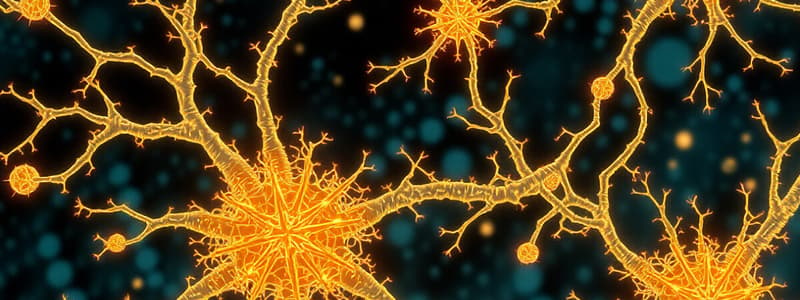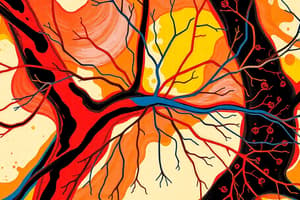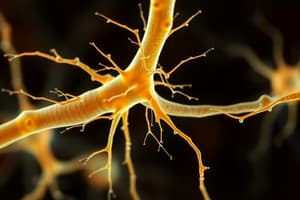Podcast
Questions and Answers
How does axon growth occur in mature axons that have already contacted their target tissue?
How does axon growth occur in mature axons that have already contacted their target tissue?
- By stretching existing microtubules.
- By adding new microtubules throughout the axon. (correct)
- By a combination of stretching and adding new microtubules at the growth cone.
- By adding new microtubules exclusively at the growth cone.
What is the shape of a growth cone when the axon is growing rapidly?
What is the shape of a growth cone when the axon is growing rapidly?
- Wide and fan-shaped with many filopodia.
- Irregular with a complex network of filopodia.
- Slim and pointed with few filopodia. (correct)
- Small and round with short filopodia.
What happens to the growth cone at a choice point in the axon's path?
What happens to the growth cone at a choice point in the axon's path?
- It changes shape to match the shape of the choice point.
- It splits into multiple growth cones to explore different paths.
- It grows larger and extends filopodia in various directions. (correct)
- It shrinks and becomes inactive.
Where does the growth cone's speed tend to slow down?
Where does the growth cone's speed tend to slow down?
What is a non-permissive substrate, and what effect does it have on axon growth?
What is a non-permissive substrate, and what effect does it have on axon growth?
What is CSPG, and how does it affect axon growth?
What is CSPG, and how does it affect axon growth?
What two cytoskeleton components meet in the peripheral zone of vertebrate growth cones?
What two cytoskeleton components meet in the peripheral zone of vertebrate growth cones?
How can the growth of microtubules in an axon be visualized?
How can the growth of microtubules in an axon be visualized?
What is the role of profilin in the treadmilling cycle of actin filaments?
What is the role of profilin in the treadmilling cycle of actin filaments?
What happens to the growth cone when actin filaments are depolymerised by cytochalasin?
What happens to the growth cone when actin filaments are depolymerised by cytochalasin?
Which of the following statements accurately describes the 'clutch mechanism' in axon guidance?
Which of the following statements accurately describes the 'clutch mechanism' in axon guidance?
What is the difference between long-range and short-range cues in axon guidance?
What is the difference between long-range and short-range cues in axon guidance?
How do microtubules contribute to axon branch formation?
How do microtubules contribute to axon branch formation?
Which of the following statements correctly describes the role of cofilin in the treadmilling cycle of actin filaments?
Which of the following statements correctly describes the role of cofilin in the treadmilling cycle of actin filaments?
What is the main difference between axon collaterals and bifurcations?
What is the main difference between axon collaterals and bifurcations?
What is the function of guidance cues in axon guidance?
What is the function of guidance cues in axon guidance?
How does the stabilization of microtubules affect the growth cone's movement?
How does the stabilization of microtubules affect the growth cone's movement?
Which of the following is NOT a characteristic of the engorgement phase of the growth cone?
Which of the following is NOT a characteristic of the engorgement phase of the growth cone?
Flashcards
Axon Growth Mechanism
Axon Growth Mechanism
Methods by which axons increase in length, including adding microtubules and stretching.
Growing by Adding Microtubules
Growing by Adding Microtubules
New microtubules are added at the distal end of the axon, allowing growth in length.
Bleached Area Experiment
Bleached Area Experiment
Experiment showing that microtubules are added to the distal end while the midsection remains stationary.
Growth and Stretching
Growth and Stretching
Signup and view all the flashcards
Growth Cone Characteristics
Growth Cone Characteristics
Signup and view all the flashcards
Growth Cone at Choice Points
Growth Cone at Choice Points
Signup and view all the flashcards
Non-Permissive Substrates
Non-Permissive Substrates
Signup and view all the flashcards
Cytoskeleton in Axon Growth
Cytoskeleton in Axon Growth
Signup and view all the flashcards
Actin Treadmilling
Actin Treadmilling
Signup and view all the flashcards
Profilin
Profilin
Signup and view all the flashcards
Cofilin
Cofilin
Signup and view all the flashcards
Growth Cone Phases
Growth Cone Phases
Signup and view all the flashcards
Growth Cone Steering
Growth Cone Steering
Signup and view all the flashcards
Long-range Cues
Long-range Cues
Signup and view all the flashcards
Short-range Cues
Short-range Cues
Signup and view all the flashcards
Clutch Mechanism
Clutch Mechanism
Signup and view all the flashcards
Collaterals
Collaterals
Signup and view all the flashcards
Axon Protrusions
Axon Protrusions
Signup and view all the flashcards
Study Notes
Axon Growth Mechanisms
- Axons grow by adding new microtubules at their distal ends. Fluorescently labeled microtubules show growth occurs distally, leaving a bleached area mid-axon.
- Mature axons, already in contact with their target tissues, grow by adding material along their entire length, not just at the growth cone. Young axons, not yet in contact, grow primarily at the growth cone.
Growth Cone Characteristics
- Growth cone shape varies based on environment and growth phase.
- Fast growth: Slim, pointed, few filopodia.
- Choice point: Enlarged, many filopodia in various directions.
- Target area: Smaller than choice point, still exploring with filopodia.
- Growth cone speed varies by location. Faster in optic tracts, slower at choice points (e.g., between optic tract and tectum) and in the tectum itself.
- Non-permissive substrates (like CSPG) cause growth cone turns.
Cytoskeletal Factors in Axon Growth
- Actin filaments and microtubules interact in the growth cone's peripheral zone.
- Treadmilling of actin filaments uses profilin and cofilin to control polymerization and depolymerization at the plus and minus ends, respectively. This dynamic balance influences growth.
- Four Phases of Growth Cone:
- Encounter substrate: Filopodia contact attractive surface.
- Protrusion: Filopodia extend further,
- Engorgement: Filopodia pull growth cone into substrate.
- Consolidation: Axon shaft forms, filopodia seek new substrates.
- Cytoskeletal control of growth direction:
- Depolymerizing actin (cytochalasin) causes turn towards stable filaments.
- Stabilizing microtubules (taxol) causes turn towards stable microtubules.
- Destabilizing microtubules (nocodazole) causes turn towards stable microtubules.
- Guidance cues from receptors influence the growth cone through stabilization signaling
- Long-range cues (secreted), specify direction but not path.
- Short-range cues specify pathway (same molecule may be attractive or repulsive).
- Actin depolymerization halts axon growth and target tissue finding.
The Clutch Mechanism
- Explains how growth cones generate traction. Guidance molecules, cytoskeleton, and linker molecules are involved in transmitting signals from environment to cytoskeleton.
Axon Branching
- Collateral branching (main axon with side branches) is the most common branching method.
- Branch formation: Protrusions form containing actin filaments. Microtubule migration stabilizes these into branches. Without stabilization/attractive signal, protrusions will regress.
Studying That Suits You
Use AI to generate personalized quizzes and flashcards to suit your learning preferences.




